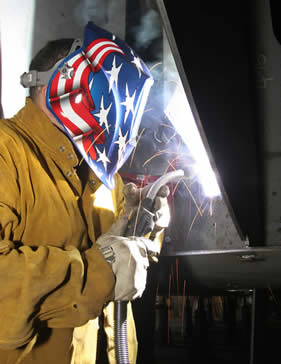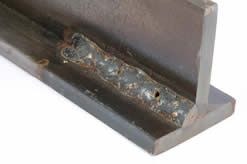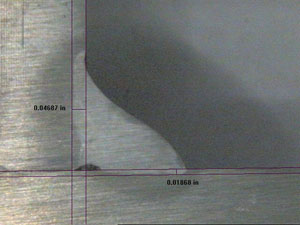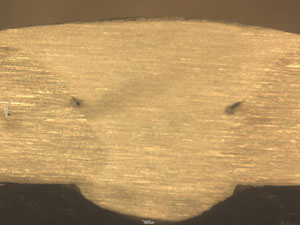The Causes of GMAW Flaws … and the Cures to Help Welding Operators Get Back to Work Faster

Weld flaws come in all shapes, sizes and degrees of severity. Yet one thing holds true regardless of the application or material on which they occur: They are a common, and costly, cause of downtime and lost productivity. They are also an occurrence that even the most skilled welder can experience.
In the GMAW process, specifically, there are several typical weld flaws that can transpire. From porosity to undercut and burn through, each has multiple causes. Fortunately, there are also numerous cures that can help welding operators minimize their frustration over weld flaws and get back to work faster.
Porosity
When gas becomes trapped along the surface or inside of the weld metal, porosity occurs. Like other weld flaws, porosity results in a weak weld that must be ground out and reworked.

or the GMAW gun are free of leaks can help solve the problem.
Causes: Typically, inadequate or contaminated shielding gas is the culprit of porosity. Using a nozzle that is too small for the application, or a nozzle full of weld spatter, can also cause this weld flaw. Having a dirty base metal and/or extending the welding wire too far beyond the nozzle is an additional cause. On warm days, air currents from cooling fans can disrupt the shielding gas envelope around the weld puddle creating this problem. Another common cause is a poor seal or a loose fitting in the shielding gas channel through the welding gun. Any gas leaks have the potential to aspirate air into the gas flow.
Cures: To correct porosity, ensure that that there is adequate gas flow (increasing it as needed), and replace any damaged gas hoses or GMAW gun components that may be causing leaks. Also, place a welding screen around the work area if welding outside or in an area inside that is particularly drafty. Check that the nozzle being used is large enough for the application and replace with a larger one if it is not. Remove any spatter build up in the nozzle. Extend the welding wire no more than 1/2 inch beyond the nozzle and make certain that the base metal is clean prior to welding. Slowing travel speed to gain greater shielding gas coverage can also combat porosity, as can keeping the nozzle within 1/4- to 1/2-inch of the base metal during welding.
Burn Through
Just as its name implies, burn through results when the weld metal penetrates fully through the base metal, essentially “burning through” it. It is most common on thin materials, particular those that are 1/4 inch or less. Another weld flaw, excessive penetration (too much penetration into the weld joint), can very often lead to burn through.
Causes: Excessive heat is the primary cause of burn through. Having too large of a root opening on the weld joint can also result in burn through.
Cures: If burn through occurs, lowering the voltage or wire feed speed can help rectify the problem. Increasing travel speed helps, too, especially when welding on aluminum, which is prone to heat build-up. If a wide root opening is the suspected cause of burn-through, increasing the wire extension and/or using a weaving technique during welding can help minimize heat input and the potential for burn through.
Incomplete Joint Penetration (Lack of Penetration)

Incomplete joint penetration or lack of penetration results when there is shallow fusion between the weld metal and the base metal, rather than full penetration of the joint. It can often lead to weld cracking and joint failure.
Causes: Insufficient heat input and improper joint preparation are the main causes of incomplete joint penetration. The shielding gas mixture and wire diameter can also be a factor.
Cures: There are several cures for incomplete joint penetration, including using higher wire feed speed and/or voltages. Reducing travel speed also allows more weld metal to penetrate the joint, as does preparing and designing the joint properly. The joint should allow the welding operator to maintain the proper welding wire extension (no more than 1/2 inch beyond the nozzle) and still access the bottom of the weld joint. Make sure that the shielding gas or gas mixture, wire type and diameters are recommended for the application.
Undercutting
Undercutting is a groove or crater that occurs near the toe of the weld. When this weld flaw occurs, the weld metal fails to fill in that grooved area, resulting in a weak weld that is prone to cracking along the toes.
Causes: Excessive heat, as well as poor welding techniques, can both lead to undercutting on a weld joint.
Cures: Reducing the welding current and voltage is the first step to rectifying undercutting. Using a weaving technique in which the welding operator pauses slightly at each side of the weld bead can also help prevent this weld flaw. Additional cures include reducing travel speed to a rate that allows the weld metal to fill out the joint completely and adjusting the angle of the GMAW gun to point more directly toward the weld joint.
Hot Cracking
Hot cracking typically appears along the length of a weld or directly next to it almost immediately after the weld puddle solidifies. This weld flaw occurs at temperatures greater than 1,000 degrees Fahrenheit (538 Celsius). There are multiple variations of hot cracking including centerline, bead shape and crater cracks.
Causes: Hot cracking can result from several factors. These include poor fit-up or joint design, creating too thin of welds and welding at too high of voltages. High levels of base metal impurities can also cause this weld flaw. In some cases, high levels of specific alloys (boron, for example) in filler metals can cause the problem.
Cures: Having the proper joint design and good part fit up is one way to help prevent hot cracking, as it keeps the weld puddle the appropriate size and minimizes the chance of the throat of the weld being too thin. In the case of crater cracking, in particular, using a backfill technique (backing up to fill in the joint fully) can minimize cracking by adding throat thickness to the crater weldment. Careful filler metal selection and shielding gas selection is also imperative.
Incomplete Fusion

When the weld metal fails to completely fuse with the base metal or with the preceding weld bead in multi-pass applications, incomplete fusion can occur. Some people also refer to this weld flaw as cold lap or lack of fusion.
Causes: Most often the cause of incomplete fusion is an incorrect gun angle, although contaminants on the base metal can also cause this weld flaw. In some instances, insufficient heat can be the culprit.
Cures: First, clean the base metal properly prior to welding, making sure it is free of dirt, oil, grease or other debris. Next, welding operators should place their GMAW gun at an angle of zero to 15 degrees in order to access the groove of the weld joint fully and keep the arc on the leading edge of the weldpuddle. Increase travel speed as necessary to keep the arc from getting too far ahead of the weld puddle. For joints requiring a weaving technique, holding the arc on the sidewall for a moment can help prevent incomplete fusion. Make certain, too, that there is enough heat input to fuse the weld metal and base metal fully. Increase the voltage range and adjust the wire feed speed as necessary to complete the weldment.
Remember, even the most skilled welding operators can experience weld flaws. The key to keeping them from affecting productivity and increasing costs in the welding operation is to identify and rectify the problems as quickly as possible. Proper maintenance of the welding equipment is also imperative. Repair or replace any worn or defective items.


